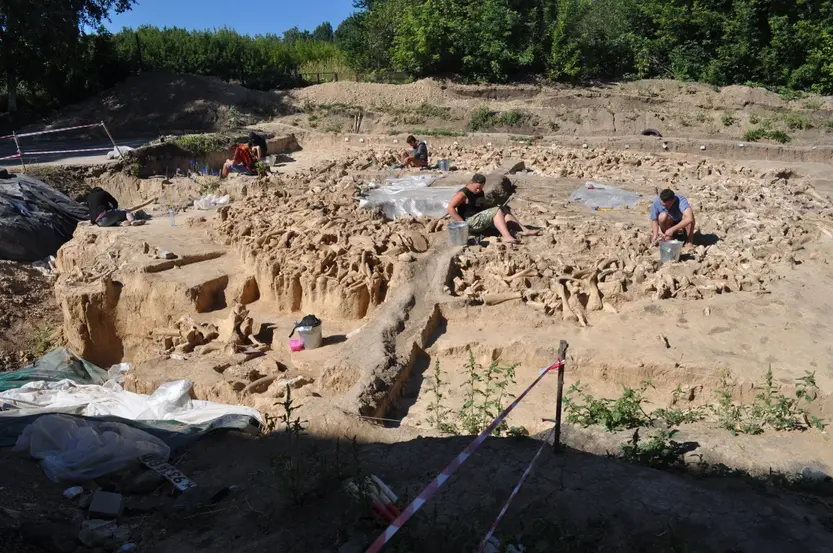In a significant archaeological breakthrough, researchers have uncovered the remains of ancient mastodons in the highlands of Peru. These large prehistoric creatures, which roamed the Earth during the Ice Age, are believed to have thrived in the region tens of thousands of years ago. The discovery not only sheds light on the types of megafauna that once inhabited South America but also offers important clues about the environmental and climatic conditions of the time.
A Glimpse Into Peru’s Ice Age Past
The excavation site, located in the Andean highlands, has yielded well-preserved mastodon bones, suggesting that the area once served as a habitat for these massive creatures. Mastodons, relatives of modern elephants, roamed vast stretches of North and South America during the Pleistocene Epoch, a period known for its ice ages and dramatic climate shifts.
While mastodon fossils have been found in other parts of South America, the discovery in Peru is unique due to the location’s high altitude and tropical latitude. These factors suggest that the mastodons may have adapted to survive in environments that were both colder and more rugged than previously thought.
According to Dr. Carlos Salinas, the lead researcher on the project, “This discovery is a remarkable opportunity to understand how these ancient animals lived in such a unique ecosystem. Finding mastodon remains at this altitude challenges our assumptions about their adaptability and distribution.”
Unraveling the Mystery of Megafauna Extinction
Mastodons were part of a broader group of large animals, often referred to as “megafauna,” that roamed the planet during the Ice Age. Alongside giant sloths, saber-toothed cats, and mammoths, mastodons dominated the ancient landscape. However, like many megafauna species, they disappeared from the Earth approximately 10,000 years ago, a phenomenon that remains a subject of intense scientific debate.
The prevailing theories suggest that a combination of climate change and human activity contributed to the extinction of these giants. The rapid warming of the planet following the last glacial maximum likely altered the habitats these animals depended on, reducing their food sources and driving them to extinction. Simultaneously, the arrival of early human populations, who are believed to have hunted mastodons for meat and other resources, could have exacerbated their decline.
The discovery of mastodon remains in Peru offers researchers a valuable window into the Ice Age ecosystem, which may help to resolve some of the lingering questions about megafauna extinction. By analyzing the fossils and their surrounding environment, scientists hope to reconstruct the climatic conditions of the period and better understand the challenges these animals faced in their final years.
What the Remains Reveal
Preliminary analysis of the fossils indicates that the mastodons likely weighed several tons and stood at least 10 feet tall at the shoulder, with massive tusks extending several feet in length. The teeth of the mastodons were especially well-preserved, allowing researchers to determine their diet, which primarily consisted of vegetation such as leaves, twigs, and possibly aquatic plants.
In addition to the mastodon bones, researchers also found evidence of other ancient animals that may have shared the same habitat. Remains of prehistoric horses and camelids, both of which also went extinct during the late Pleistocene, were discovered at the site. These findings suggest that the area once hosted a rich diversity of species, providing further insight into the prehistoric ecosystem.
Dr. Salinas notes, “The variety of remains we’ve uncovered suggests that this region supported a diverse range of megafauna. It’s possible that this was a thriving ecosystem where multiple species coexisted before the environment changed drastically at the end of the Ice Age.”
The Significance of the Discovery
The mastodon discovery in Peru is more than just a scientific milestone; it represents a broader effort to uncover and preserve the history of ancient life in South America. As researchers continue to investigate the site, they hope to unlock new information about the interactions between humans and megafauna, as well as the ways in which these animals adapted to survive in diverse environments.
Additionally, the findings may also provide clues about the movements of ancient human populations. Evidence of early human presence has been found in Peru, suggesting that humans may have migrated through the region during the Ice Age. If humans and mastodons coexisted in this region, it could offer new insights into how early populations hunted and interacted with these massive creatures.
Dr. Mariana Ruiz, an archaeologist involved in the project, emphasizes the importance of understanding the relationship between early humans and megafauna. “This discovery gives us the chance to explore how ancient people may have used these animals for food, tools, and even shelter. The extinction of megafauna was a turning point in human history, and by studying sites like this, we can gain a deeper understanding of that transition.”
Global Implications of the Peruvian Find
While the discovery of mastodon remains in Peru is a regional breakthrough, its significance extends globally. Similar discoveries in other parts of the world, such as North America and Eurasia, have helped shape our understanding of the Ice Age. Each new find contributes to the larger puzzle of how climate change, environmental factors, and human activity intertwined to shape the fate of megafauna.
By comparing the Peruvian remains to those found in other parts of the Americas, researchers hope to determine whether similar environmental pressures affected mastodons across different regions. They are particularly interested in examining whether mastodons in tropical environments faced different challenges compared to those in colder climates.
The discovery also highlights the importance of preserving archaeological sites. As development and agriculture expand into previously untouched regions, many potential fossil sites are at risk of being lost. By protecting these areas, researchers can continue to unearth critical evidence that contributes to our understanding of the planet’s history and the factors that have shaped life on Earth.
Looking Ahead: Future Research and Exploration
With the current excavation ongoing, researchers plan to conduct more detailed analyses of the mastodon remains. Radiocarbon dating will provide a clearer timeline of when these creatures lived in the region, while DNA analysis may reveal new information about their genetics and evolutionary history.
In addition, the research team intends to expand their search for other megafauna remains in the surrounding area. They hope to uncover more evidence of the diverse species that once roamed the region, as well as possible signs of human activity.
The Peruvian government has also expressed interest in preserving the site as a national heritage landmark, recognizing its potential to attract both scientific research and tourism. Plans are underway to establish a dedicated research center and museum near the excavation site, which will allow the public to learn more about Peru’s rich Ice Age history.
A New Chapter in Ice Age Discovery
The discovery of mastodon remains in Peru is a remarkable achievement that provides new insights into the ancient world. As scientists continue to study these prehistoric giants, they are not only unearthing the secrets of the past but also deepening our understanding of how species adapt—or fail to adapt—to environmental change. In a time of rapid global warming and biodiversity loss, these discoveries remind us of the fragility of ecosystems and the importance of learning from history to protect the future.
This breakthrough marks an exciting new chapter in our understanding of the Ice Age and the diverse life forms that once thrived in South America’s highlands. It’s a story that continues to unfold, with many more revelations likely to emerge in the years to come.





